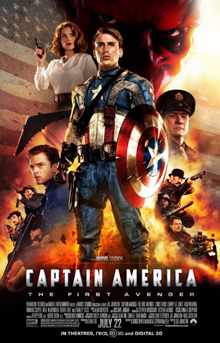
Marvel has been in film for years. From Sam Raimi’s Spider-Man to Bryan Singer’s X-Men. However, fans are receiving a new movie to awe at in the form of Joe Johnston’s Captain America: The First Avenger. The film features a new take on the character of Captain America with stunning graphics and exciting edge-of-your-seat moments that are sure to thrill. That’s not to say there aren’t any problems with the film but we’ll get to that soon. With a 140 mil. budget, Marvel Studios was certainly not wasting time on this film. On the coattails of May’s Thor film, there was much more story to be told before The Avengers, coming out next year. Captain America: The First Avenger is certainly not a film to miss for fans of the film series.
Captain America is set in 1943 and as many are well aware it is centred around World War II. Strangely enough, a war flick seems to work well for Marvel. Much of the film is spot on when it comes to the WWII era. When Steve, the film’s protagonist, is trying to enlist at the film’s start, the recruiting officer stamps his papers with a 4F, which means “unable to serve for medical reasons,” according to Selective Services. This is true as Steve is shown to be incredibly weak and diseased. However, the film goes on to explain that he has attempted to enlist multiple times under many names. He is told that such action is illegal which is true based on accounts from the era. In addition to these, there are many indications of the era which are perfect for the time period. For example, there are many posters for Samuel J. Friedman Theatre, which would have been in New York at the time, where the film takes place. Children are also shown to be reading Captain America comics which were widely popular at the time. Later in the film, references to the state of the world are made subtly but add to the setting a great deal. The antagonist, Red Skull, states that Hitler has left his soldiers hungry which is true as many Nazi soldiers ate “ersatz food” due to a lack of supplies. One of the side protagonists, Jim Morita, is annoyed when Steve asks “What? Are we taking everybody?” upon seeing Jim, who is Japanese-American, referencing the Japanese internment camps and anti-japanese sentiment at the time. While it is certain that someone at Marvel Studios did their homework for the film, there are a few inconsistencies. Of course, there are things that set Marvel apart from other war films such as energy-based weapons and androids, that could never fit the period, there are some serious problems with the film.
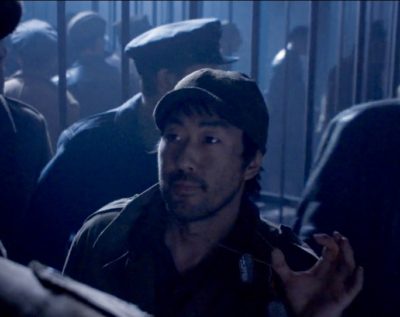
During the scene in which Steve attempts to enlist, his list of medical issues is shown. Among these are Scarlet Fever, Rheumatic Fever, and Sinusitis. All of these diseases are short-term and have no lasting side effects. Thus, they should not be listed as current issues but medical history. It seems that someone took a list of diseases and copied them onto the list rather than researching them. Later in the film, Steve is copying a list of weapons factories that he had seen in a HYDRA base. Only the last one is heard but is stated to be 34 miles west of the Maginot Line. The Maginot Line was a French defence during WWI, not WWII where the film takes place. Later, while infiltrating a HYDRA train, one character, Union Jack, says “Mind the Gap” before jumping on. While Union Jack is British and “Mind the Gap” is a British saying, it did not come into being until 1968, 25 years after the events of the film. Otherwise, the film’s setting is airtight. However, the believability of the film itself lacks a little more than an out of place quote.

Despite all the research into the characters and time period, some things didn’t make much sense. First of all, was the character of Steve Rogers. He is shown to be purely patriotic but the film never explains why he is so. He is just blindly following America no matter what they are doing which doesn’t make him that different from anyone else is the 1940s. Some scenes just feel rushed and wrong. For example, the scene where Steve chases a HYDRA agent through Brooklyn is missing something. It is hard to explain without giving away the story itself but upon watching the film you would understand. On the other hand, HYDRA’s energy-based weaponry is inconsistent as sometimes, it simply vaporizes things, sometimes it just dissipates, and other times it blows up in large or small blasts. Also, kamikaze bomber planes are shown with different major cities marked on them indicating where they should be landing. However, one says London indicating that that should be the next stop for the Valkyrie, HYDRA’s battle plane.
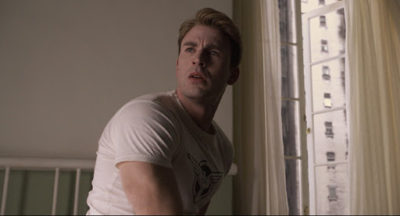
However, Steve later states that the plane is heading directly to New York City and that there wouldn’t be enough time to land the plane safely. However, he is shown to be flying over Scandinavia, with London between Steve and New York City. The entire scene makes little sense. At the end of the film, Steve wakes up in a room intended to be a recreation of 1943. Meanwhile, a baseball game is playing on a radio, which Steve states is a Dodgers-Phillies game from May 25th, 1941. The problem with this scene is that no recordings of this game exist for SHIELD to have used to recreate the scene. There many more problems with the film but not enough time so we’ll have to move on for now.
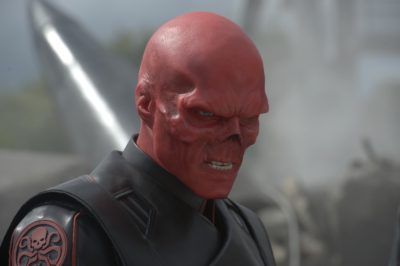
Nothing can alter a movie more than Visual Effects (VFX). VFX is the key to making someone feel like they are experiencing the events of the film instead of just hearing about it. It’s what separates cinema from books or audio dramas and Captain America does not disappoint. The energy blasts from the HYDRA weapons are stunningly realistic. At one point in the film, flamethrowers are used and the heat is visibly refracting the scene around it in such an amazing way. Also, Red Skull’s design is practically perfect though occasionally waxy in appearance. However, none of this compares to the initial size and shape of Steve Rogers at the start of the film. He begins as a small, weak boy with barely enough meat on his bones to keep him from falling apart. However, the face is still Chris Evans, the actor who plays Steve throughout the movie. Then, just a few scenes later, Evans is in full muscles. This is thanks in part to Leander Deeny, Chris Evans’ double, and the VFX team at Marvel Studios who scaled down Evans to fit onto Deeny’s body. However, there are some issues with the VFX of the film. Some backgrounds are obviously fake such as those in the wreckage of an old bar. Also, explosions seem to be in every scene almost to the point of a Michael Bay film. The lighting for the film is strange and not in a good way. Practically every scene in which a significant light is present, the light takes up a large percentage of the scene taking away from whatever the scene is supposed to be bringing to the film. Nonetheless, a thumbs-up to the VFX team on this one.
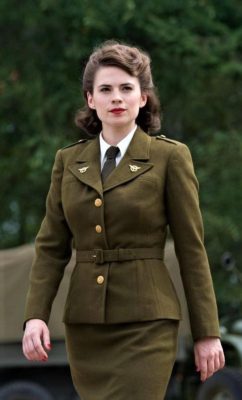
Besides simple VFX, it is important for the actors to portray the characters correctly and in a reasonable fashion. Captain America succeeds in this category with only a few character issues present. Firstly, Chris Evans seems to really embody Captain America in the film in such a way that is quite convincing and allows the audience to believe what is happening. Hayley Atwell is Agent Carter in the flesh. She seems to find Steve’s rebirth just as surprising as Carter. Hugo Weaving plays the villainous Red Skull and creates his own mysterious aura of evil around the character. Kenneth Choi plays Jim Morita who may be the most era-realistic character in the film, often taking offence to anti-japanese statements. Tommy Lee Jones portrays an average colonel but adds depth to the character that may not have been present otherwise. Toby Jones brings his wide variety to this film in the form of Arnim Zola, a character that feels perfect for Jones. Dominic Cooper plays the playboy character, Howard Stark, astoundingly well though his portrayal of scientist Stark could use work as it is not completely believable. More work on this character, in general, would have been nice and added to the film. Stanley Tucci’s portrayal of Abraham Erskine is quite stunning with only the occasional break in accent. Sebastian Stan’s Bucky Barnes could use some work though the character seems to fit okay. He should have been fleshed out a little more than he was. Neal McDonough plays Dum Dum Dugan and does well. However, more of this character should have been included in some way as he could be so much more. J.J. Feild’s Union Jack seems to be a shallow character that could have used some development. Nonetheless, the casting was done quite well for this film.
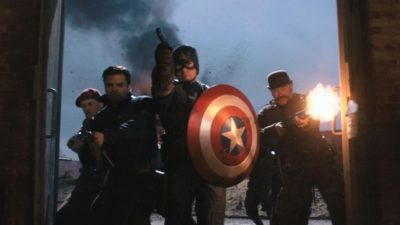
For a war flick, Captain America is surprisingly family-friendly. However, there are a few things that hurt the film’s family-friendliness. Throughout the film, occasional mild language is used so not great for young children right off the bat. Blood is often shown in small quantities, though at one point a HYDRA soldier is shredded in a propeller, though not very graphic. There is a large amount of gun and hand-to-hand violence which makes sense as this is a war film. Alcohol is present in various scenes throughout the film.
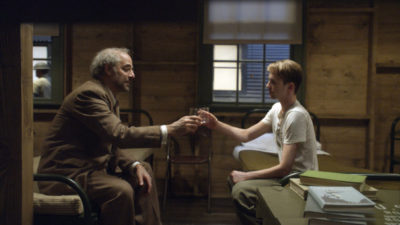
Characters are shown intoxicated and Steve remarks his sadness that he cannot “get drunk” after a major loss. Men are shown undressed above the waist in a recruitment office so averting the eyes of girls may be preferred if you so wish. Throughout the film, romantic and non-romantic kissing scenes are shown as well as some innuendo. Steve asks Peggy if she and Howard Stark “fondue,” under the impression that fondue is some form of physical relations. So, there are some things that some families may not agree with but others that are considered fine. That’s up to the parents, though.
Overall, The First Avenger is a well-made and good film, despite occasional issues here and there. Taking account of the character and plot errors and casting problems, this film probably ranks an 8.5 out of 10. So, why not go see it for yourself? It’ll hold you at the edge of your seat from beginning to end.
